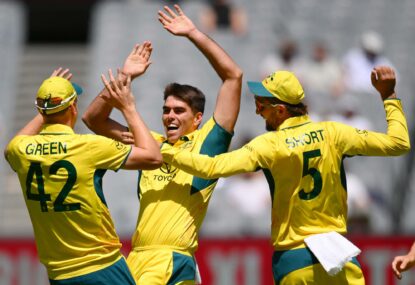The seventh edition of the Indian Premier League kicks off on 16 April, with 23 Australian cricketers set to ply their trade in the competition this year.
This edition of the IPL will be played across two legs, with UAE hosting the first one between April 16 and 30, before the tournament moves back to India for the second in May. This has happened once before, and for the same reason – potential security issues due to general elections in the host nation.
On that occasion in 2009, the entire season was played in South Africa. This time around, the sponsors and the team owners expressed their reluctance over a similar arrangement – because of a perceived reduced bottom-line – and the BCCI acceded to splitting the competition into two legs.
The lead-up to the IPL saw the teams choose their squads from the famous IPL auction, with a small change being that players were ‘bought’ in Indian rupees instead of USD this year.
Franchises also had the option to retain a few players from the previous squads, and have the right to first refusal – a right-to-match card, as it was called. Every team could retain up to five players and depending on how many they held back, had either one, two or three right-to-match cards.
Only two Australians, Shane Watson and James Faulkner, were retained by their franchise (the Rajasthan Royals), while everyone else was released back into the auction pool.
A further total of 20 Australian cricketers were selected from the IPL auction, while as many again from the previous season went without selection. Some of them like Ricky Ponting and Gilchrist had announced their retirement, others like Ryan Harris are injured and undergoing rehabilitation, while many were simply not selected and surprisingly so.
Royals Retained
It did not come across as a shock when the Rajasthan Royals decided to retain Watson and Faulkner as two of the five allowed players.
With Rahul Dravid retiring from the shortest format of the game as well, Watson has been offered the captaincy of the IPL side he has played for from day one of the competition. It was a no-brainer given Australia do not play international cricket until June, and Watson is the most senior member of the side now.
The other retention was Faulkner, who had an excellent debut IPL season for the Royals last year.
Faulkner, who featured in a couple of matches in his first IPL season for the Kings XI Punjab in 2012, was released into the auction pool by them for the 2013 edition and Rajasthan paid $400,000 to bring him into their squad.
He proved to be a ripper of a selection. In the 16 matches that Faulkner played for the Royals in 2013, he ended with 28 wickets at an average of just over 15, which put him at the second-best position in the list of wicket-takers for the season – four behind Dwayne Bravo, who also played two more games. His economy rate was 6.75.
According to the IPL rules, retaining players from previous seasons loses teams a portion of their allowed purse to buy players from the auction, but that may or may not be the salary that the team offers to the retained players.
In short, retaining one player costs teams Rs.125 million out of their Rs.600 million purse, a second player pushes them back by a further Rs.95 million and so on until a total of all five players reduces their spending power by Rs.39 million.
But despite that, the figure that Watson and Faulkner (and any other retained players) earn out of all this remains a secret.
Potential ‘Big Shows’
Glenn Maxwell is the original Big Show, and he breached the million-dollar mark (in Australian dollars) yet again this season. After being bought by the Mumbai Indians for USD$100,000 last year, Maxwell was released into the auction pool by the defending champions but didn’t have to fret for too long.
Kings XI Punjab shelled out a whopping Rs.60 million to bring the all-rounder into their squad. And making it a double treat was the purchase of Mitchell Johnson for Rs.65 million (again, more than a million dollars) by the same team.
Interestingly, even Mitchell Johnson featured for the Mumbai Indians last season, a team he has partially credited with his turnaround in form. For them not to retain him seemed illogical, but whatever the reasons their loss has been Punjab’s gain. Or so they would hope!
The other honourable mentions in this list are Sunrisers Hyderabad’s David Warner (Rs.55 million), Mumbai Indians’ Michael Hussey (Rs.50 million) and Mitchell Starc of the Royal Challengers Bangalore, purchased for Rs.50 million.
Hussey makes for an interesting case study. Along with Suresh Raina, he has easily been Chennai’s most consistent batsman, possessing the ability to score aplenty at quite a high strike-rate, yet he wasn’t retained by the side.
Was it to do with the fact that Hussey, supposedly inadvertently, revealed Gurunath Meiyappan’s role as the owner of the Super Kings? We can only hazard a guess here.
On the other hand, the Mumbai Indians were in the need of solidity at the top of the order after the retirement of Sachin Tendulkar and the non-retention of Hussey came at the most opportune moment.
They spent a whopping amount alright, but the Mumbai Indians will be happy with their selection of the left-handed Sydney Thunder captain.





































































































